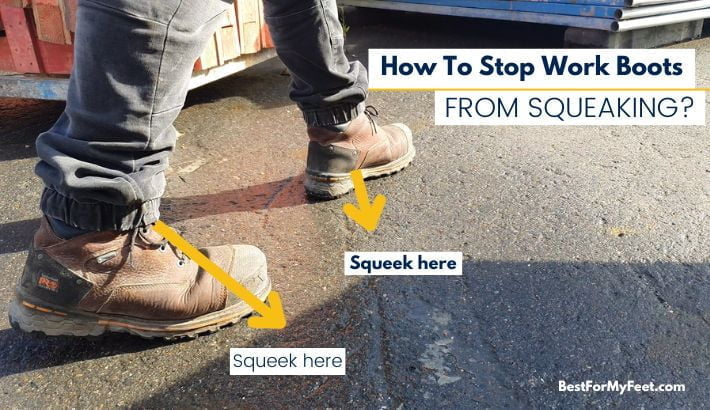Don’t you just hate it when the work boots you’ve spent a small fortune on, although looking the business, and are really comfortable, squeak when you walk?
I certainly do. Especially when it’s only one boot. I’d rather it was both boots or none.
Hopefully, this article will help you learn some possible causes of the squeaking, and what you can do to stop it.
Who’s working on this page

Jimmy Webb
Author & Researcher

Victor Adrian
Researcher & Editor
Why do our work boots squeak?
Because we’re ahead of the game, some of the reasons why work boots squeak have been covered in a previous article.
Here is a summary of the points covered in that article, plus some extra points.
- Friction between the insole and outsole of the boot.
- Friction between the rubber outsole and the surface you’re walking on.
- Friction between the different leather parts of the boots.
- Wear and tear from old boots.
- Wearing the boots with no socks.
- Water or moisture in the boots.
- Brand new boots that are faulty.
- Bottom of the outsole is too smooth.
- Shoelaces generating the squeak.
Tips that will help prevent or stop work boots from squeaking
I used the word ‘prevent’ because prevention is better than rectifying, and some of the points given will both prevent and resolve the problem.

1. Break in your work boots
When you first buy new boots, they smell nice, they look good, you just want to take them out into the world and get to work in them. This isn’t a good idea.
You should always break in your work boots first. This slowly softens and flexes the materials, molding the boots to your feet before you take them out in the elements.

2. Sprinkle Talcum powder between the insole and the footbed
When walking, try to figure out exactly where the squeak is coming from. You’ll probably be able to hear its location, but you’ll also sometimes feel the vibrations.
If you get the feeling that the squeak is coming from inside the boots, there’s a high chance it’s caused by friction between the inner sole and midsole or upper lining (the latter, if the inner sole is stiff and curls up against the lining of the boot).
In this instance, Talcum powder is a good remedy. All you do is take the inner sole out and sprinkle the powder over the bottom of the boot.
This will reduce friction. It will also remove excess moisture, keeping the boots fresh.
Let the boots rest for at least a day to absorb the powder, then dust away any excess before putting the insoles back.
3. Get some new insoles
The insoles will get old and worn. They sometimes move around inside the boots, and this rubbing can cause the squeaking.
You can get around this by either buying new insoles, or if they’re not too worn, glue them down to the footbeds of the boots (this is a pretty extreme measure though).

4. Pack underneath the squeaking area of the insole
Buying new insoles won’t guarantee the squeaking will stop. In fact, depending
on what ones you get, the new ones might even cause the noise, particularly if they’re very stiff.
I had this experience myself after fitting some really nice cork arch support insoles (the SOLE Performance cork insoles).
They’re very stiff, and to be honest, I didn’t heat them first before using them, so I would suggest doing this to mold them better and faster. From the moment I started using them, one boot constantly squeaked.
Luckily, Adrian, our wonderful editor, and webmaster, gave me a tip.
The squeaking came from the back of the heel area, where the insole curls up the boot a little. Adrian advised me to pack the area with something.
So that’s what I did. I folded a small piece of paper over and over into a strip, and placed it around the shape of the back of the heel so that the insole could rest on top of it instead of sliding up and down.
This is a simple tip if you don’t want to glue, or if you don’t want to fork out on other insoles.
4. Rough up the bottom of the outsoles with sandpaper
We’ve covered the insole. What about the outsole?
Well, most of our work boot outsoles are made of types of rubber. On certain surfaces, rubber will squeak. Think of your car tires when you go around tight corners sometimes.

Smooth, shiny surfaces are usually the culprits. Like polished concrete or tiled floors.
All you need to do is rough the soles up a little. Get some sandpaper and lightly and evenly rub it over the bottom of the soles. This will give the soles more texture, and probably more grip.
But don’t go too mad with the rubbing. You don’t want to ruin the soles.
5. Glue separated outsoles back, have them repaired professionally, or replace the boots
These soles sometimes come detached from the boots over time (also known as sole delamination). Especially at the heels and toes. Not only might this cause squeaking, but it will also give you wet feet.
Your options are to either glue the soles back on to the rubber, have a cobbler resole them for you, or buy new work boots.
If you glue them back, first clean any dirt out of the gap, otherwise, the glue will stick to the dirt rather than the surfaces. Then put masking tape next to the damaged areas, anywhere you don’t want excess glue to show. Just like you would when painting at home, or when spraying vehicles.
When all this prep work is done, use matchsticks, or something similar, to spread the glue onto the surfaces, making sure to get into all the cracks.
Hold the surfaces together firmly. You could put one hand or an object inside the boot to assist in clamping if you need to. But remember, it’s not about how long you clamp for. It’s about the firmness.
Make sure you remove the tape before the glue dries, otherwise it will be very difficult to get it off.
Some glues will require a certain amount of curing time before you wear the boots. You’ll need to check the instructions.
6. Treat the upper with oil treatment
Right, we’ve gone over the insoles and the outsoles. Now we need to cover the rest of the boot. Literally.
Softening the boot material using oil conditioning should help. Clean your work boots first and let them dry naturally or use a boot dryer, then remove the laces.
You might as well give them a clean while you’re at it. Finally, evenly apply the conditioning using a microfiber cloth.
Be sure to apply oil on the tongue as well, as in some cases, friction between the tongue and the laces could cause friction.
Editor Note
Personally, I use mink oil to condition my leather work boots.
Sometimes I use boots oil too, especially if what I’m trying to do is to waterproof my leather work boots.
Overall it seems to be a better solution for waterproofing as I’ve discovered when comparing mink oil vs boots oil but there are other leather conditioning products out there.
7. Use saddle soap on the tongue and inside the upper

If the noise is coming from the tongue area specifically, another trick is to use saddle soap, which is commonly used to lubricate horse saddles.
Take the laces out of the boots, then rub the saddle soup into a microfiber cloth. Hold the tongue firmly on the inside and rub the soap over the tongue and interior of the upper, around the lace eyelets.
8. Return brand new work boots if they squeak straight away
However, if your brand-new boots are squeaking straight out of the box, there’s
probably a fault.
During manufacturing, the upper and the sole is made separately, then attached together.
If this attachment isn’t done properly, or even if the soles aren’t made correctly, pockets of air can form in the sole. This trapped air can burst out of the pockets when walking, thus causing the squeak.
In this instance, it’s best to return the boots. Most boot companies will provide a warranty, but there should always be a return policy in stores within a certain amount of time.
9. Make sure the boots are always dry
Dampness can be a big problem in causing squeaking. It can come from the environment, i.e., rain, snow, etc, or from our own sweat.
You can fight this by drying your boots every day after work. This is best practice anyway, regardless of squeaking.
If your boots get consistently wet, making them too difficult to dry naturally, a quality boot dryer is an excellent investment. My colleague Adrian is using this PEET Original boot dryer. It’s a no-nonsense, cheap, and effective boot dryer.
10. Replace the boots, they got old
Finally, there comes a point when our boots need retirement. Sometimes, they get so old and battered that repairing or rebuilding just isn’t worth the effort or money.
The materials develop cracks, or the leather gets comes apart. These things can cause all kinds of funny noises, so it’s probably best to say goodbye to our old, trusted friends and make way for new ones.
It might be painful, but after a while, those old boots will be a distant memory.
In conclusion
We hope you’ve found this article interesting and informative. All the bases should be covered.
You should now know most of the reasons why work boots squeak, and lots of useful tips to both prevent the squeaking and stop it altogether.
The important thing to remember is to find the exact location of the squeaking before acting. Otherwise, you could create unnecessary expenses, or even cause other issues.
Now enjoy your peaceful walking without people staring at you. And enjoy the spring in your steps.
Team Members Working On This Page

Jimmy Webb – Writer And Researcher
Hey, Jimmy here. I’m one of the researchers and writers here at BestForMyFeet.com. I’ve been wearing work boots all my life working as a forklift driver, landscaper, groundworker, and now as a tower crane operator so I know a few things about footwear and footcare in general. I’m also working on my first novel. So writing IS my passion. When I’m not writing I love to spend time with my wife, two children, and furball.

Victor Adrian – Editor And Webmaster
Construction Professional, driver, crane operator, cleaner, head chef … these are just some of the jobs I did in the past. Working in all these different environments taught me that having good footwear to protect your feet from different dangers at work IS PARAMOUNT for any worker! On this website, I aim to share all my knowledge and personal experience in dealing with different footwear and foot care issues, and hopefully, you can get something out of it. Enjoy!
source https://bestformyfeet.com/how-to-stop-work-boots-from-squeaking/

No comments:
Post a Comment